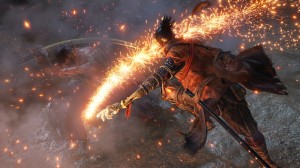Sekiro: Shadows Die Twice

by Sean Martin
reviewed on PC
EVOLUTION
The games made by FromSoftware are always in a state of change. Some things stay the same — the boss battles, the third person, the grinding difficulty, but what makes each game a flavourful and distinctive installment, changes every time. After Dark Souls, Bloodborne innovated with a more aggressive combat system, flipping the table upon all the Dark Souls users who’d relied on shields, even going so far as to mock shields in Bloodborne’s item descriptions, claiming they ‘engender passivity’. In very much the same way, Sekiro: Shadows Die Twice, could be considered an evolution of Bloodborne, retaining that games idea of rewarding aggression, but now with the inclusion of stealth, platforming, and flipping the parry system upon its head.
You play as Wolf, a Shinobi in medieval Japan. After being found on a battlefield as an orphan, he was trained by a Shinobi master, Owl, and sworn into the iron code, to serve under child-lord Kuro, heir of the Divine Blood. Long story short, some events occur and Kuro is kidnapped, while Wolf is left for dead, having lost an arm. With the help of the Sculptor, Wolf is given the Shinobi Prosthetic, a mechanical arm which allows him to grapple, create a shield, smash heads with an axe, shoot flame, and many other wonderful feats. One other thing — for some reason Wolf is unable to die. With all this he sets out into the land of Ashina to liberate the kidnapped Kuro and defeat any who cross his path.
SWORDPLAY
There is only one weapon in Sekiro, Wolf’s Katana, but how you use it can differ greatly. The new inclusion to this game is the ‘Posture’ mechanic — as opposed to Bloodborne where one parry unbalances an opponent, now you must fill the enemy’s Posture meter to unbalance them. This can be accomplished in a variety of ways — attacking with the sword and parrying at the right time, but if you block an attack incorrectly or are hit, your posture meter will go up, risking the option that you might become unbalanced instead. When an opponent is unbalanced, you can perform a killing blow, which will insta-kill an enemy, or remove a wound from a boss (bosses generally have one or two).
The alternative option is of course, to play the long game, dodging around an opponent and slashing where you can, but this is far less viable. If anything, I would say that this is the only downside with Sekiro, that boss approachability is far more limited than in the ‘Soulsborne’ games. Combat is Sekiro is entirely risk vs. Reward. If you go in sword blazing you might die very quickly after a few missteps, but the boss could also be over far sooner. To add some variation to this, you can also use stealth before a boss is engaged, which gives you the opportunity to remove a wound from them before the fight has even begun. Also the Shinobi prosthetic has a range of tools which you can use in a fight, whether blinding an opponent with firecrackers, or smashing their guard with the axe. On top of this, there is the final option to resurrect once, a mechanic which relies upon the curse ‘Soulsborne’ players know so well, of having died ridiculously close to winning a fight. But beware, this may have repercussions on the world at large.
ASHINA
The main story takes place in the land of the Ashina, a province coming under increasing pressure as the Ministry for the Interior tries to wipe out the ruling clan. The eldest son of the Ashina, Genchiro, is becoming desperate as the clan’s enemies close in from all sides, and this desperation can be seen throughout the game. Ashina is a dying land of ancient mysteries, heroes and monsters, and Wolf must face many of them, as Genchiro has shackled them to fight for the clan. Wolf must also face the other factions creeping into the dying land in the hopes of feeding on the corpse. All in all, this allows for a good mixture of human and monster, as well as both supernatural and realistic, boss fights. The scenery is also absolutely spectacular, perfectly channeling medieval Japan, while also adding a strange folkloric twist.
While not a ‘Soulsborne’, Sekiro is a must-play for any fan of those previous games. Just as players who first moved from Dark Souls to Bloodborne found it a tough adjustment, so to will those picking up Sekiro. But ultimately, it will prove worth it as you experience the rewarding feeling of tackling a difficult boss, and the new dynamic combat that Posture and the Shinobi Prosthetic create. It is a game that will be more to the taste of Bloodborne players than Dark Souls players, but if you enjoy tough yet rewarding gameplay, and an interesting world exploration, filled with scenery and intermittent boss fights, Sekiro will be for you.
9.2
fun score
Pros
Great ‘Posture’ system, beautiful scenery, good mixture of human and monster bosses.
Cons
Boss fight approachability can feel limited sometimes, if you can’t parry or learn to parry, this game is going to be a lot harder.







